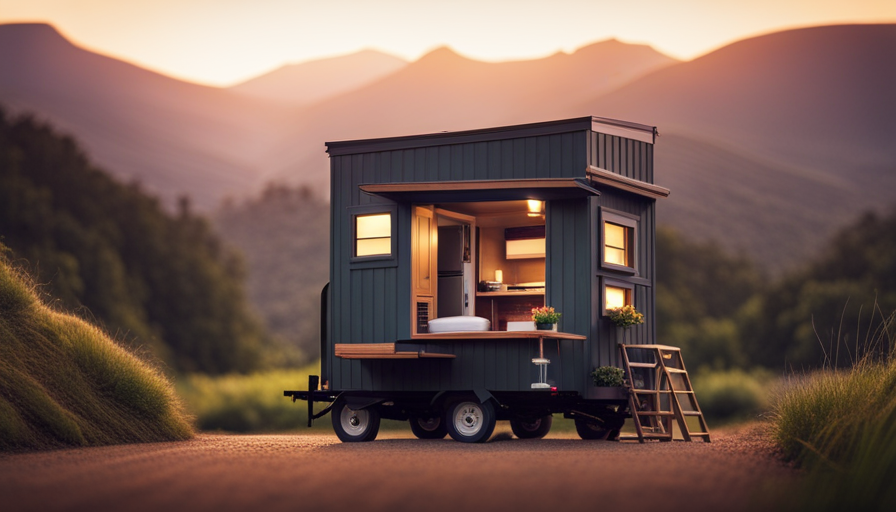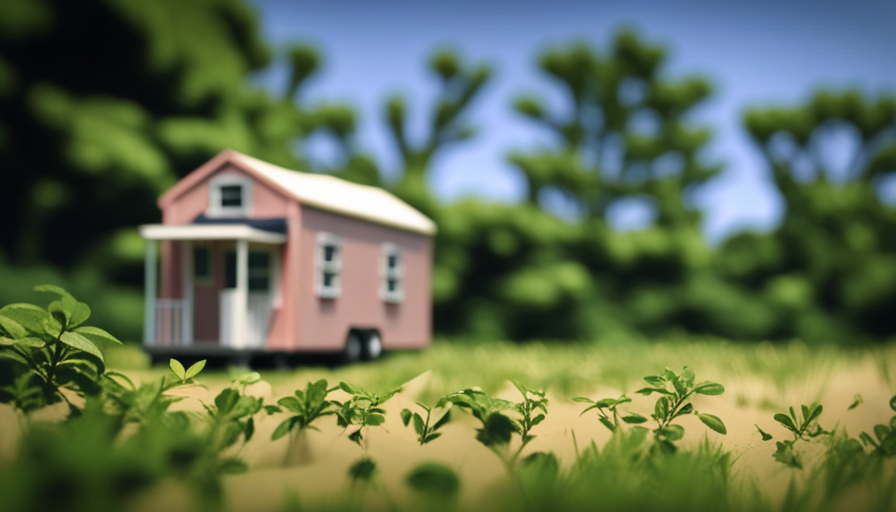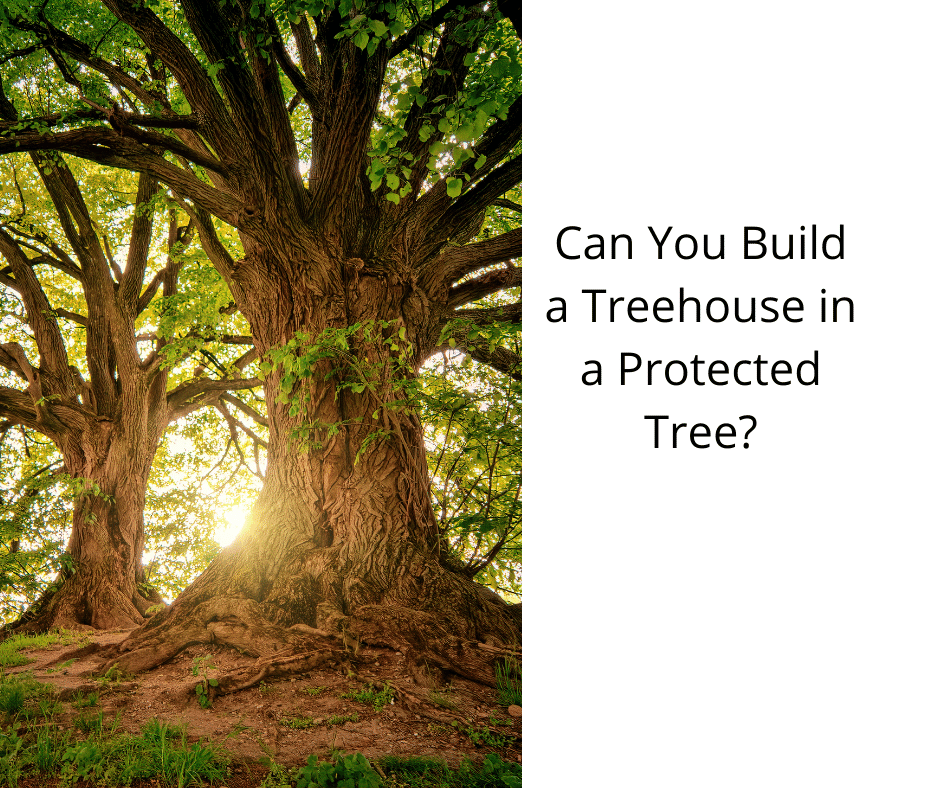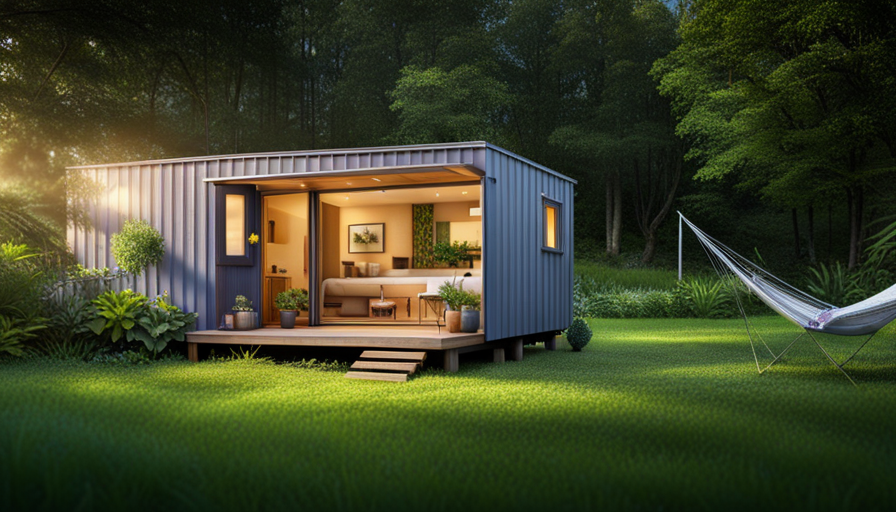The saying, ‘good things come in small packages,’ truly captures the magical world of tiny house living. Choosing a tiny house on wheels has become popular among those seeking a simpler, environmentally friendly lifestyle. But one might ask, what is the largest size these portable tiny homes can be?
In this article, I will delve into the legal requirements and size limitations that govern the dimensions of a tiny house on a trailer. I will also explore the importance of designing a functional and efficient space, utilizing creative storage solutions, and maximizing natural light and airflow. Additionally, I will provide insights on choosing the right trailer for your tiny house and embracing a minimalist lifestyle.
So, if you’re curious about the possibilities of living large in a small space, keep reading to uncover the secrets of how big a tiny house on a trailer can truly be.
Key Takeaways
- Tiny house living is gaining popularity as people seek a simpler and more sustainable lifestyle.
- There are legal requirements and size limitations for building tiny houses on trailers, so it is important to research and understand these regulations before starting a project.
- Designing a tiny house with functional and efficient space is crucial to make the most of the limited square footage.
- Creative storage solutions can optimize the layout of a tiny house, allowing for maximum use of space and minimizing clutter.
Understanding the Concept of Tiny House Living
Imagine living in a tiny house, where you can simplify your life and experience the freedom of living in a compact space. The tiny house movement is gaining popularity as people realize the benefits of downsizing. By embracing minimalism, you can reduce clutter, decrease expenses, and have a smaller environmental footprint.
Living in a tiny house allows you to focus on what truly matters, such as spending quality time with loved ones and pursuing your passions. However, it’s important to be aware of the legal requirements and size limitations when it comes to building a tiny house on a trailer. Understanding these regulations will ensure that you stay within the boundaries set by local authorities and avoid any potential issues.
Legal Requirements and Size Limitations
If you’re thinking about building a mobile dwelling, it’s important to consider the legal requirements and size limitations that apply, so you can stay within the regulations and avoid any potential penalties or restrictions. Did you know that according to the National Fire Protection Association, the maximum width for a tiny house on a trailer is typically 8.5 feet? This is just one example of the legal restrictions that may be in place when it comes to building a tiny house on a trailer. Zoning regulations also play a role in determining the size limitations of your tiny house. It’s crucial to research and understand these regulations before you start your project to ensure compliance. By following these guidelines, you can design a functional and efficient space for your tiny house on a trailer.
Designing a Functional and Efficient Space
Consider the various ways you can optimize the layout and organization of your mobile dwelling to create a space that’s both practical and efficient for your needs.
When designing the interior layout of your tiny house on a trailer, it’s crucial to make every square inch count. One effective strategy is to utilize multi-purpose furniture, such as a dining table that can transform into a workspace or a sofa that can convert into a bed. This allows you to maximize the functionality of each piece while minimizing the amount of space it occupies.
By carefully planning the placement of your furniture and fixtures, you can ensure that there’s a logical flow and ample room for movement within your tiny home.
Now, let’s explore how you can further enhance the functionality of your space by utilizing creative storage solutions.
Utilizing Creative Storage Solutions
To optimize your mobile dwelling’s layout, think outside the box and utilize creative storage solutions to maximize space and enhance functionality. Here are three space-saving furniture and vertical storage options to consider:
-
Wall-mounted foldable tables and beds: These versatile pieces of furniture can be folded out when needed and tucked away when not in use, freeing up valuable floor space.
-
Multi-functional storage ottomans: These stylish pieces serve as both seating and storage, providing a convenient place to store items such as blankets, books, and shoes.
-
Vertical shelving units: Take advantage of vertical space by installing tall shelving units that can accommodate various items, such as books, kitchenware, and clothing.
By incorporating these storage solutions into your tiny house design, you can maximize space and keep your belongings organized.
Now, let’s explore how to maximize natural light and airflow in your mobile dwelling.
Maximizing Natural Light and Airflow
Take advantage of the abundant natural light and refreshing airflow in your mobile home by implementing smart design strategies. Maximizing natural light not only helps create a spacious and open feel, but it also reduces the need for artificial lighting, maximizing energy efficiency. Incorporating large windows, skylights, and glass doors can flood your tiny house with sunlight, making it feel larger and more inviting. Additionally, strategically placing windows to capture cross ventilation can enhance airflow, keeping your home cool and fresh. To help paint a picture, imagine a three-column and four-row table showcasing different window placements and their impact on natural light and airflow. Don’t forget to consider incorporating outdoor living spaces, such as a porch or deck, to further connect with nature and expand your living area. Moving on to the next section about choosing the right trailer for your tiny house, let’s explore the options available.
Choosing the Right Trailer for Your Tiny House
When it comes to building a tiny house on a trailer, one of the most important decisions you’ll make is choosing the right trailer.
There are various custom trailer options available to suit your specific needs and preferences. It’s crucial to consider the towing capacity of the trailer, as it will determine how big your tiny house can be. Towing capacity is influenced by factors such as the weight of the trailer, the weight of your tiny house, and the towing vehicle’s capabilities.
By carefully assessing these considerations, you can ensure that your tiny house is not only safe to tow but also meets your desired size requirements.
With the right trailer in place, you’ll be able to embark on your journey of embracing a minimalist lifestyle in a tiny home seamlessly.
Embracing a Minimalist Lifestyle in a Tiny Home
Embracing a minimalist lifestyle in a tiny home can bring about a sense of freedom and simplicity that’s often lacking in our modern world.
One of the key aspects of living in a tiny home is adopting minimalist decor. This means choosing furniture and decor items that are functional, practical, and serve multiple purposes. By minimizing clutter and focusing on essential items, you create a living space that feels open and uncluttered.
Another benefit of downsizing to a tiny home is the opportunity to simplify your life. With limited space, you’re forced to prioritize what’s truly important to you. This can lead to a more intentional and fulfilling life, as you spend less time and energy on material possessions and more on experiences and relationships.
Embracing a minimalist lifestyle in a tiny home is a transformative experience that allows you to focus on what truly matters.
Frequently Asked Questions
How much does it cost to build a tiny house on a trailer?
Building a tiny house on a trailer can vary in cost depending on your preferences and the building materials you choose. To give you a cost estimate, it’s important to consider factors such as size, design, and features. Building materials, like wood or metal, will also impact the overall cost. However, without knowing the size of the tiny house, it’s difficult to provide an exact cost.
Can I legally live in a tiny house on a trailer full-time?
Yes, it’s possible to live in a tiny house on a trailer full-time, but it depends on the zoning regulations in your area. Zoning laws vary from place to place, so it’s important to research and comply with the specific regulations in your location.
Some areas allow full-time living in tiny houses on trailers, while others have restrictions or require certain permits. It’s crucial to understand and follow these regulations to live legally in a tiny house on a trailer.
Are there any restrictions on where I can park my tiny house on a trailer?
Parking restrictions and zoning regulations dictate where you can park your tiny house on a trailer. It’s essential to research and comply with local laws to avoid any legal issues.
These restrictions may limit parking locations, such as residential areas or certain zones. Some areas may require permits or have specific size limitations for trailers.
Being aware of these regulations will help you find a suitable and legal parking spot for your tiny house on a trailer.
Do I need a special driver’s license to tow a tiny house on a trailer?
Yes, in some states, a special driver’s license is required to tow a tiny house on a trailer. The specific type of license needed may vary depending on the weight and size of the trailer. It’s important to check with your local Department of Motor Vehicles to understand the towing regulations in your area. They can provide you with the necessary information and requirements for obtaining the appropriate license.
How do I insure a tiny house on a trailer?
Insuring a tiny house on a trailer can be quite a journey. First, you’ll want to ensure that your insurance policy meets the necessary requirements for coverage.
This includes liability coverage in case of any accidents or damages. Additionally, you may want to consider coverage options for theft, fire, or natural disasters.
It’s important to do your research and find an insurance provider that specializes in tiny houses on trailers to ensure you’re adequately protected.
Now, let’s talk about the size of that tiny house…
Conclusion
In conclusion, tiny house living offers a unique and fulfilling way of life. While there may be legal requirements and size limitations to consider, designing a functional and efficient space is key to maximizing your tiny home’s potential.
Creative storage solutions, natural light, and airflow are essential elements to consider when constructing your tiny house. Additionally, choosing the right trailer is crucial for mobility and stability.
Despite the challenges, embracing a minimalist lifestyle in a tiny home can lead to a more sustainable and rewarding life. So why not start your tiny house journey today?
Hi, I’m Emma. I’m the Editor in Chief of Tiny House 43, a blog all about tiny houses. While tree houses are often associated with childhood, they can be the perfect adult retreat. They offer a cozy space to relax and unwind, surrounded by nature. And since they’re typically built on stilts or raised platforms, they offer stunning views that traditional homes simply can’t match. If you’re looking for a unique and romantic getaway, a tree house tiny house might just be the perfect option.










